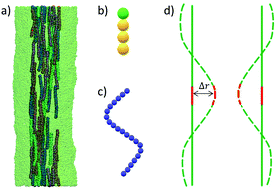Membrane nanotube pearling restricted by confined polymers†
Abstract
Increasing evidence showed that membrane nanotubes readily undergo pearling in response to external stimuli, while long tubular membrane structures have been observed connecting cells and functioning as channels for intercellular transport, raising a fundamental question of how the stability of membrane nanotubes is maintained in the cellular environment. Here, combining dissipative particle dynamics simulations, free energy calculations, and a force analysis, we propose and demonstrate that nanotube pearling can be restricted by confined polymers, which can be DNA and protein chains transported through the nanotubes, or actin filaments participating in tube formation and elongation. Thermodynamically, nanotube pearling releases the membrane surface energy, but costs bending energies of both the membrane and the confined polymers. Following the mechanism, the pearling of nanotubes confining longer and stiffer polymers is more difficult as it costs larger polymer bending energies. In dynamics, nanotube pearling occurs by repelling polymers from the region of nanotube shrinking to that of swelling. Shorter polymers can be readily repelled owing to the unbalanced force exerted by the shrinking tube region, whereas longer polymers tend to be trapped at the shrinking region to retard the nanotube pearling. Besides the low surface tension maintained by lipid reservoirs kept in living cells, our results supplement the explanation for the stability of membrane nanotubes, and open up a new avenue to manipulate the shape deformation of tubular membrane structures for study of many biological processes.



 Please wait while we load your content...
Please wait while we load your content...